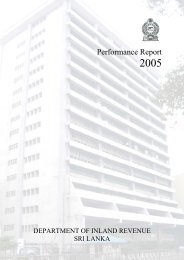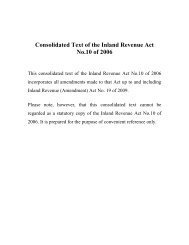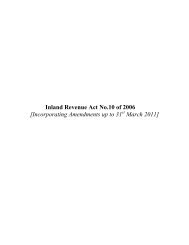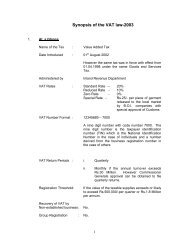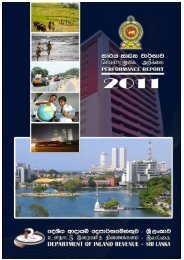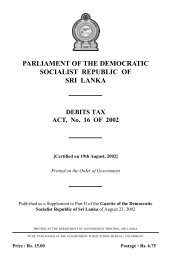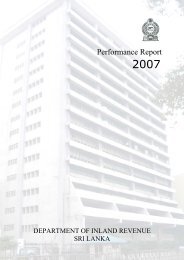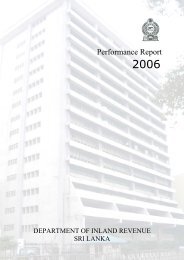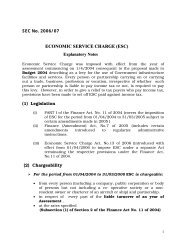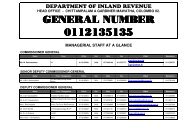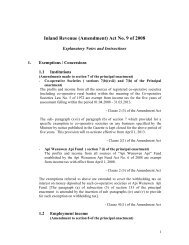VAT Guide to Value Added Tax - sri lanka inland revenue ...
VAT Guide to Value Added Tax - sri lanka inland revenue ...
VAT Guide to Value Added Tax - sri lanka inland revenue ...
Create successful ePaper yourself
Turn your PDF publications into a flip-book with our unique Google optimized e-Paper software.
the H.S. classification it may be brought <strong>to</strong> the notice of the DGC and CGIR for<br />
necessary amendments. Sometimes there may be difficulties in identifying<br />
goods as declared in import documents. For example the <strong>VAT</strong> Act speaks of<br />
labora<strong>to</strong>ry reagents, raw materials used for pharmaceutical products, medical<br />
instruments, semi-precious s<strong>to</strong>nes etc. But the individual names of these<br />
reagents, products, instruments and s<strong>to</strong>nes may not be appearing in the H.S.<br />
Code or may be appearing under inappropriate H.S. headings so that is it<br />
difficult <strong>to</strong> decide on the <strong>VAT</strong> rate applicable <strong>to</strong> a particular item that is imported.<br />
In such situations CGIR will give directions <strong>to</strong> the Cus<strong>to</strong>ms, with regard <strong>to</strong> the<br />
rate of <strong>VAT</strong> applicable after identifying the items on the basis of expert opinion<br />
and/or recommendations and other material placed before him. Such<br />
recommendations are obtained solely for the purpose of identifying the goods<br />
only (Please see para 10.3) Once the goods are properly identified the rate of<br />
<strong>VAT</strong> will be decided in accordance with the <strong>VAT</strong> Act eventhough an<br />
incorrect rate may appear in the H.S. Code due <strong>to</strong> inadvertence or<br />
inadequacy in classification. However the valuation for the purpose of<br />
calculating <strong>VAT</strong> is the responsibility of the D.G.C as the valuation depends on the<br />
C.I.F <strong>Value</strong>. Even if the goods are imported on N.F.E basis and even if the<br />
goods are exempted from Cus<strong>to</strong>ms duty, the C.I.F will be ascertained by the<br />
Cus<strong>to</strong>ms in accordance with the Cus<strong>to</strong>ms Ordinance for the purpose of<br />
calculating <strong>VAT</strong> and other levies. Importers are advised <strong>to</strong> verify the <strong>VAT</strong> rates<br />
(and exemptions) applicable <strong>to</strong> their intended imports beforehand from the H.S.<br />
Code <strong>Guide</strong> in order <strong>to</strong> avoid any repercussions that may arise after import.<br />
• <strong>VAT</strong> on approved local sales of garments by BOI exporters is also collected from<br />
the buyers by the Cus<strong>to</strong>ms at Rs. 25/- per piece in the same manner as in the<br />
case of imports<br />
5.1.3 Exempt supplies<br />
<strong>VAT</strong> is not collected on exempt supplies of goods & services. List of exempt<br />
supplies are given in Schedule 1 <strong>to</strong> the <strong>VAT</strong> Act. Please see Chapter 10..<br />
5.2 Payment of <strong>VAT</strong> <strong>to</strong> C.G.I.R<br />
As stated in para 2.5 <strong>VAT</strong> is paid in the first instance by the consumers <strong>to</strong> the Registered<br />
Persons from whom they purchase goods & services. Thereafter the Registered<br />
persons are required <strong>to</strong> remit the <strong>VAT</strong> collected by them <strong>to</strong> the Commissioner General of<br />
Inland Revenue as provided in Section 22 of the Act. That Section allows the Registered<br />
Persons <strong>to</strong> deduct the <strong>VAT</strong> paid by them on the goods and services used by them<br />
34



